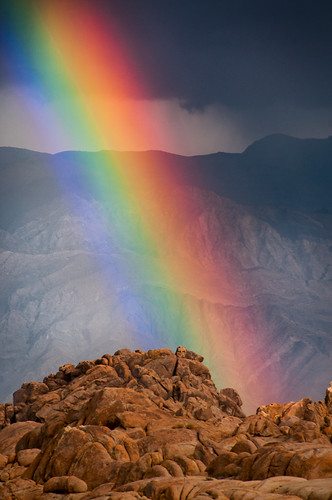
Rainbow, photo by Harold Davis. View this image larger.
So the number one trick with rainbows is to be there with your camera when there is a rainbow. Rainbows need rainy weather—or at least clouds that are loaded with moisture—and sunshine. So days with rain that stops and starts are good bets, as is a storm system that is coming to an end. Don’t forget the sunshine part of the equation: it’s as important as the clouds.
You also want side lighting. I rarely see strong rainbows on the axis of the sun. These things are formed when the sunlight strikes moisture in the clouds, revealing the prismatic refractions that occur when light travels through the curvature in raindrops. For example, in this shot sunlight was coming strongly from the right, out of the photo.
The angle of light that creates rainbows is perfect for a circular Polarizing filter. When I see a rainbow forming, I almost always pull my Polarizer out of my bag. If I rotate the Polarizer, depending upon the rotation, the rainbow almost completely disappears—or becomes much stronger, with richer colors. You can bank on adding some zip to a rainbow’s colors using a Polarizer—it’s about as close to a sure thing as you get in landscape photography.
As I explained in the linked story, this rainbow was a bonus feature during last month’s night photography workshop in the Alabama Hills. After a while, you get a nose for rainbow weather—and rainbows certainly seemed likely on the day I shot this one. If you join Steven and myself for next year’s workshop (tentatively scheduled for November, 2011) who knows—we may see another rainbow!
ken.fruit
6 Dec 2010Professor Walter Lewin from MIT give a great lecture on the physics of the rainbow here:
http://www.youtube.com/watch?v=p9iB2PALVeY
Don’t let the mathematics intimidate you, you can enjoy the lecture whether or not you can do the math.
There are no words to describe Lewin as a lecturer in physics other than “Lewin is a god!”
Pingback: Double Double | Photoblog 2.0